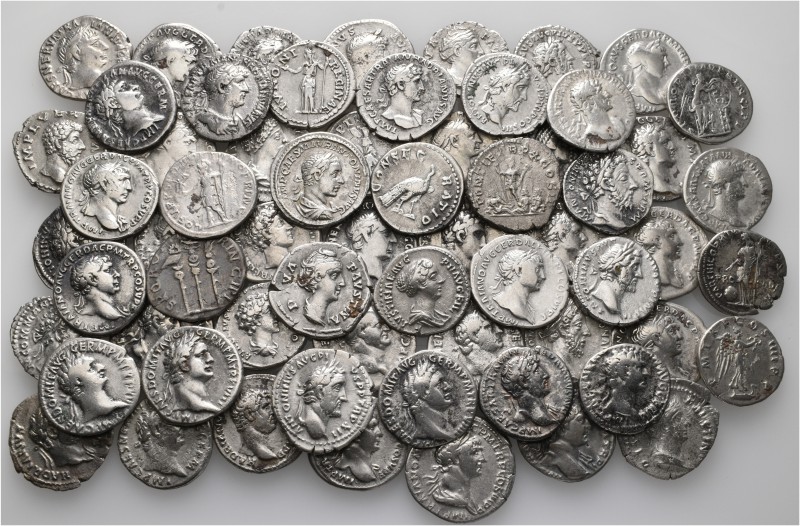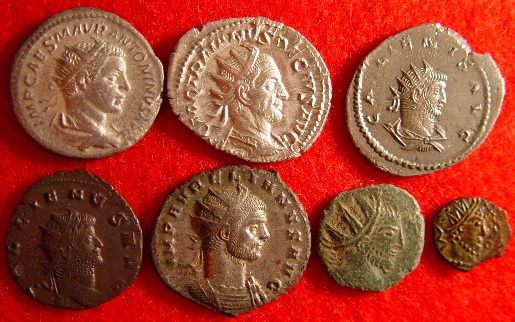Types of Greek coins #
Drachm #
Basic denomination, according to the Attic standard it weights around 4,3g. Equals six obols. Name means “a handful” or “a grasp” in Greek and is related to holding six rods of iron obols in one’s hand. Example of a drachm – minted in Lampsakos after the death of Alexander the Great. 4,21g, 17mm.
Obol #
initially an iron rod used as currency before coins were invented, later usually a silver coin of about 0,78g. Six obols equal one drachm. Example of an obol – Mysia, Lampsakos, 500-450 BC. 0,83g, 12mm.
Tetradrachm #
Equals 4 drachmae and weights around 17.2g. according to the Attic standard. In some places its weight was reduced to 12,6g (in case of cistophoric tetradrachms of Asia Minor) or 14,2g. (in Ptolemaic Egypt). Tetradrachms with reduced weight circulated only in the states which minted them and all people arriving there had to exchange their own money for locally minted one, since using foreign coins was forbidden.
Because foreign merchants had to exchange their heavier tetradrachms for lighter ones – the state was receiving a surplus of silver in such exchange. One of the most famous tetradrachms – Athenian tetradrachm, also called “an owl” (17,22g, 25mm)
Along with these three most famous denominations – there were also dekadrachms (10 drachmae), didrachms (2 drachmae), tetrobols (4 obols), triobols (3 obols, also known as hemidrachm – “half-drachm”), diobols (two obols), tetartemorions (1/4 obol), trihemitartemorions (one and a half tetartemorion), hemiobols (“half-obols” or 2 tetartemorions), tritartemorions (3 tetartemorions) and the smallest denomination of all – hemitetartemorion – half of tetartemorion weighting around 0.09g (if you own it – don’t drop it! 😉 ).
In addition to this, in the Greek world there were also “staters”, (equal to 2 drachmae, meaning “weight” and being the translation of semitic “shekel” which meant the same thing).
Famous examples are Corinthian Staters (8,63g, 21mm):

Staters of Aegina, following its own weight standard (12,19g, 18mm):

Greek states minted plenty of various bronze coins and a handful of gold ones as well. All major kingdoms (Ptolemaic, Seleukid, Macedonian) issued bronze coins necessary for basic day to day transactions. Also many local civic mints produced bronze coins, sometimes just to manifest their pride of having their own coinage with local symbols on them.
Types of Roman coins #
Thanks to few centuries of existence and conquering vast territory – Roman empire needed, produced and left us huge amounts of various coins.
In early republican times the official mint was located on the Capitolline hill, near the temple of Juno Moneta. Because of that “moneta” became the word meaning “mint” and “money”, and survived to this day in many languages, for example as English “money”, French “monnaie”, Italian and Polish “moneta” or Spanish “moneda”.
Here are some more commonly collected denominations:
Denarius #
standard silver coin, introduced around 211 BC and minted for about 450 years. Its name means “tenner”, because initially it was an equivalent of 10 asses. Its weight was decreed to be 1/84th of Roman pound – about 3,9g.
Later it was retariffed to be the quivalent of 16 asses, but the name stayed the same. Early denarii had limited variety when it comes to variants of obverses and reverses. Very common reverse types consist of Dioscuri or biga/quadriga.
In time aristocrats serving their terms as moneyers (officials overseeing the mint) gained the right to design obverses and reverses as they liked, resulting in very rich variety unprecedented in ancient world and often alluding to the history of their own ancestors and families.
For example moneyers of one family were often depicting elephants on coins they minted, because one of their ancestors defeated Carthaginian army many years earlier and captured more than 100 war elephants. Denarii were initially minted of almost pure silver (up to 98% purity) and maintained weight standard for more than two centuries.
During the early imperial era it was about the average daily wage. First debasement was conducted by Nero, who reduced the weight to 3,41g. (1/96th of a pound) and fineness to 93,5%. In the next decades fineness was slowly degrading up to the point when, during the reign of Aurelian, last denarii contained only 5% silver.
A lot of denarii:

Antoninianus #
New type of silver coin introduced by Caracalla in 215 CE. Name is not contemporary, we don’t know how ancient Romans called them. Officially a double denarius, it contained less silver than two denarii. Just like denarius, they were debased by later emperors to the point where they became basically bronze coins. Disappeared at the end of 3rd century. Antoniniani can be recognized by radiate crown shown on male busts and crescent below female busts. Few examples of antoniniani

Sestertius #
First issued around 211 BC, initially a small silver coin equal to 2,5 asses or 1/4 of a denarius. Minted sporadically during Roman republic. Reintroduced by Octavian August as large coin (around 26 grams) made of orichalcum (brass) and retariffed as 1/4 of denarius and 1/100 of aureus.
Disappeared at the end of the third century with Diocletian’s reform.
Dupondius #
Orichalcum (brass) coin worth 1/2 of a sestertius and two asses, weighting around 11-15 grams. Radiate crown, introduced to dupondii by Nero, signified it’s worth two asses, though some later dupondii did not have radiate busts, making it difficult to distinguish from asses (which had the similar size and weight).
Disappeared at the end of the third century.
As #
Basic Roman coin used in day-to-day transactions during early imperial era. Weighting around 9 – 12 grams and made of copper (unlike sestertii and dupondii which were made of brass). During Roman republic they had double-headed Janus on obverse and galley prow on reverse.
Disappeared at the end of the third century.
Semis #
Derived from the word “semi” meaning “half”. Initially a small brass coin valued as 1/2 as which fell out of use during the reign of Hadrian. In late Roman empire a good quality gold coin worth 1/2 of solidus.
Quadrans #
Smallest denomination, 1/4 of an as. Fell out of use in the middle of the second century CE. Entrance to public baths cost one quadrans.
Aureus #
Gold coin, at first minted very sporadically during the Roman republic. Issued in larger quantities by Julius Caesar, who ordered to mint 40 aurei out of Roman pound (making each aureus weight 8 grams). Octavian Augustus decreed that one aureus is worth 100 sestertii or 25 denarii. Its weight was slowly being reduced in the next 200 years, but the coins maintained very high fineness, reaching 98%.
During the crisis of the third century both weight and fineness dropped significantly. Weight dropped from 7,25g to 3,6g and fineness from 98% to, in some instances, 66%. During the reign of Gallienus no gold coin heavier than one gram was minted. Aurei permanently disappeared with the reform of Constantine I.
Quinarius #
Initially small silver coin minted during the republic with value of half denarius or five asses (just like the name of “denarius” was derived from “ten”, being initially the equivalent of 10 asses, the name of “quinarius” was derived from “five”).
This name is also used by modern numismatists to describe the smaller gold coin minted during the early imperial era, weighting 1/2 of aureus.
